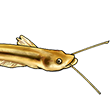You could try feeding them cactus fruit; although they would never encounter it in the wild.pleco_breeder wrote:what can be substitued from North America
I gather that yuca is another name for manioc. Probably not closely related to yucca, although I'm not certain of it.
One thing I intended to mention earlier in this thread as a botanical point is that palms are not actually trees. They evolved separately and they differ from trees in various respects. The expression 'palm tree' is a misnomer.




